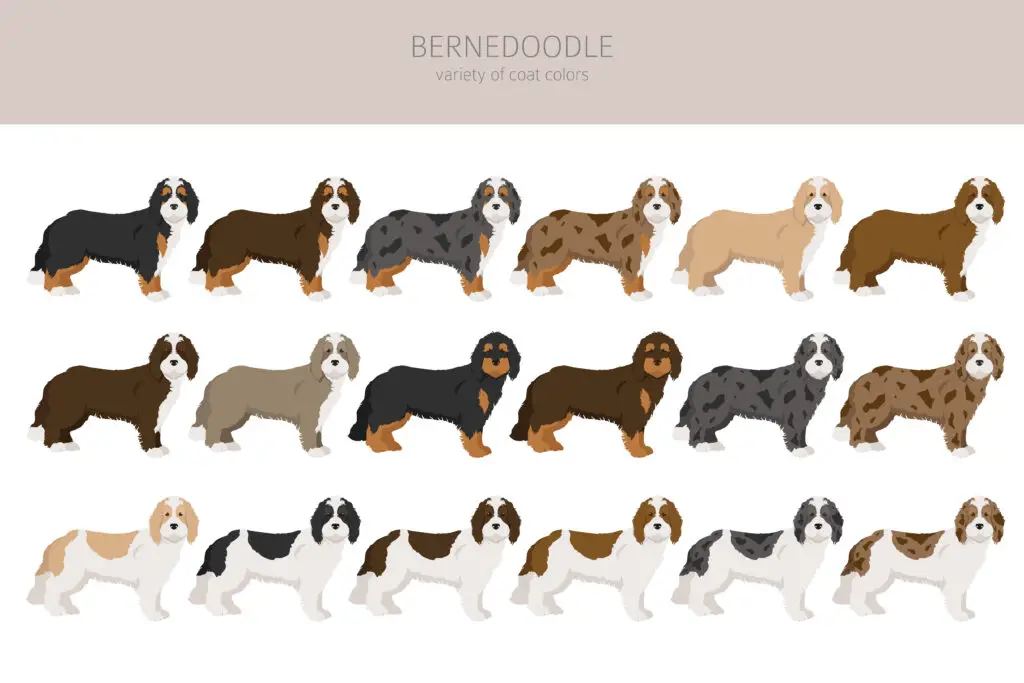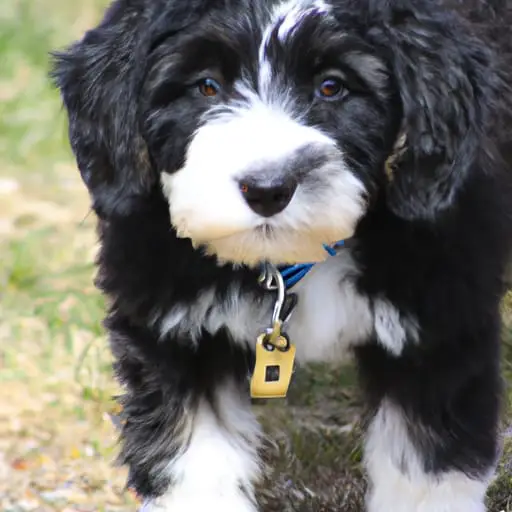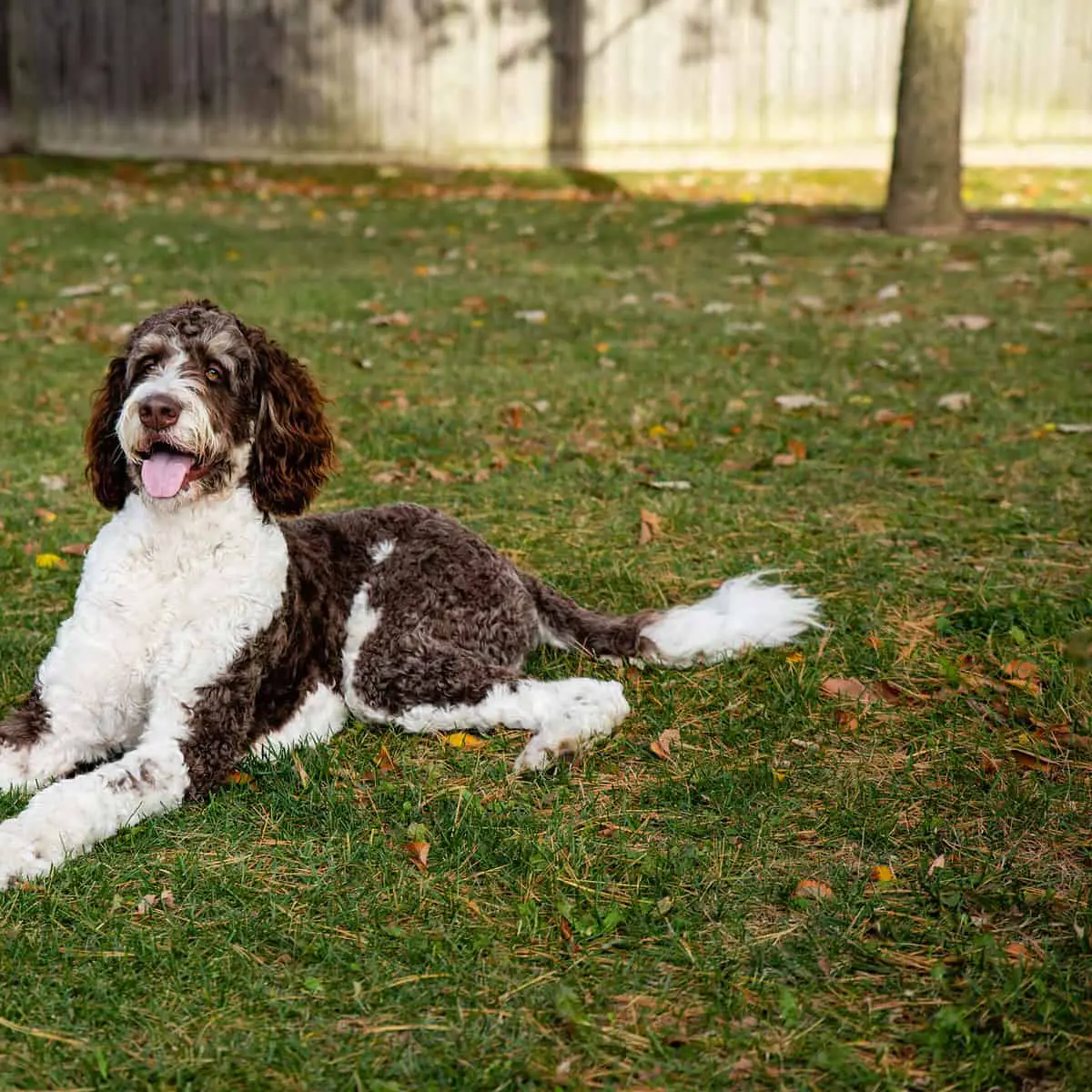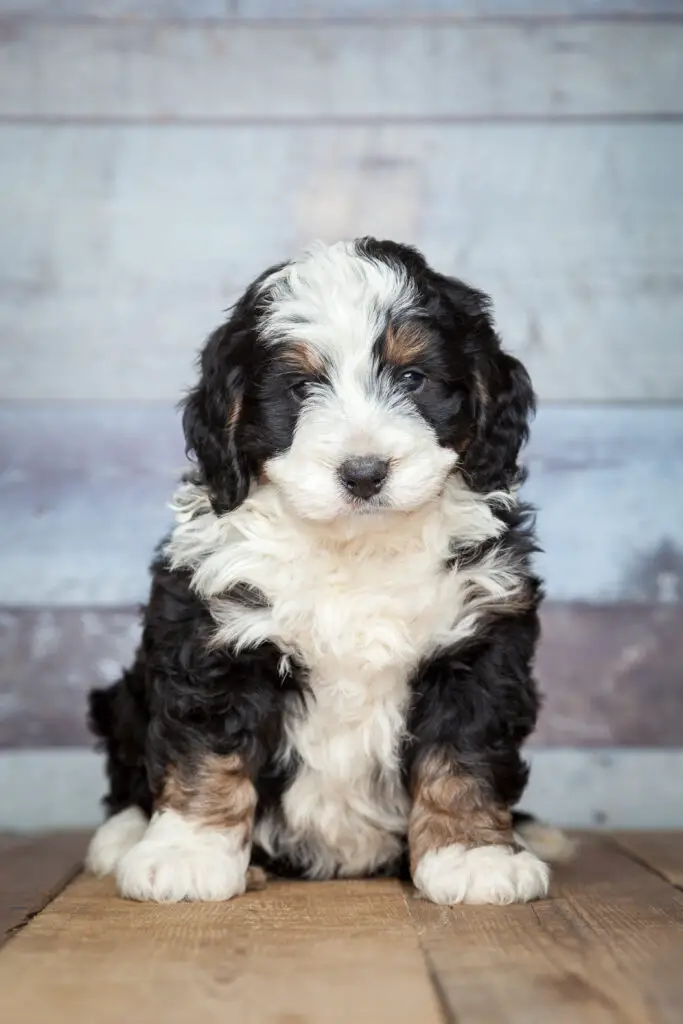Our website is supported by our users. We sometimes earn money when you click an affiliate link and make a purchase. This is at no extra cost to you and helps us to create quality content. For all that have shown us such wonderful support, we thank you from the bottom of our hearts!
The Mini Bernedoodle is a unique and adorable hybrid breed that has gained popularity in recent years. Smaller than a standard Bernedoodle, this designer breed is a cross between the Bernese Mountain Dog and the mini Poodle (bred down from the standard poodle), resulting in a small and friendly dog that is suitable for apartment living.
In this article, we will explore the history of the Mini Bernedoodle, its physical characteristics, temperament and training, health issues, grooming, owning a Mini Bernedoodle, special traits, cost of purchase, maintenance costs, finding breeders and drawbacks of owning.
History of the Mini Bernedoodle
The Mini Bernedoodle was first bred in the United States in the early 2000s. Breeders were seeking a smaller version of the standard size Bernese Mountain Dog that would be suitable for apartment living. The Bernese Mountain Dog is a large breed that is known for its loyalty and friendly nature, but its size can make it difficult to keep in small spaces.
The miniature Poodle was chosen as the second parent breed due to its intelligence, hypoallergenic coat, and small size. The Mini Bernedoodle was developed to combine the best traits of both parent breeds.
Bernedoodles are not recognized by the American Kennel Club (AKC) as they are not purebred dog breeds. However, they are recognized by the Designer Kennel Club, which is a registry for designer dog breeds.
Physical Characteristics of the Mini Bernedoodle
The Bernedoodle is a small to medium-sized dog that typically weighs between 25-50 pounds and stands 18-22 inches tall at the shoulder.
They have a sturdy and muscular build, with a square-shaped head and dark, expressive eyes.
The coat of Miniature Bernedoodles can be a curly or wavy or straight coat, and comes in a variety of colors. Coat colors include black, white, brown, and tri-color.
The Bernese Mountain Dog has a thick, double coat that sheds heavily, while the Poodle has a single, curly coat that makes it a low-shedding dog as well as a hypoallergenic dog.
Though there are no completely hypoallergenic coats, the mini bernedoodle coats will definitely not be so because of the dander created by the Bernese Mountain dog genetics.
A hypoallergenic dog cans still cause allergic reactions in sensitive allergy sufferers.
The life expectancy of of a mini berniedoodle is aour 14 to 17 years.

Temperament & Training of the Mini Bernedoodle
The Mini Bernedoodle is a friendly and affectionate dog that loves to be around people. They are known for their gentle nature, loyalty and intelligence, and can be trained to perform a variety of tasks. They are also excellent family members, they are good with young children and other pets.
These hybrid dogs are active dogs that require regular exercise and mental stimulation, as they have high energy levels and can become bored easily. They love outdoor activities and its a good idea to take them for long walks on a regular basis.
Furthermore, they are prone to separation anxiety, as many dogs are. These dogs thrive with dog owners who work from home or are stay at home parents who spend a lot of time at home.
The good news is that they are also highly trainable, and respond well to positive reinforcement training methods.
Health Issues of the Mini Bernedoodle
As with all dog breeds, the Mini Bernedoodle is prone to certain health issues. Let’s look at some of the health conditions of both of its parent breeds: the mini Poodle parent and the Bernese Mountain dog parent.
Poodles are a beloved breed known for their intelligence, playful personalities, and stunning appearance. Though they generally enjoy good health, the health concerns of the poodle are:
Hip Dysplasia
One of the most common health issues that poodles can face is hip dysplasia. This is a genetic condition that affects the hip joint, causing it to develop abnormally. This can lead to pain, stiffness, and even arthritis. While hip dysplasia is more common in larger breeds, it can also affect smaller breeds like poodles. Signs of hip dysplasia can include limping, difficulty rising, and reluctance to exercise.
Ear Infections
Another health issue that can affect poodles is ear infections. Poodles have long, floppy ears that can trap moisture and bacteria, leading to infection. Signs of an ear infection can include shaking of the head, scratching at the ear, and a foul odor. If left untreated, ear infections can lead to more serious health problems, so it’s important to take your poodle to the vet if you suspect they may have an ear infection.
Eye Problems
Poodles can also be prone to eye problems, such as cataracts and progressive retinal atrophy (PRA). Cataracts are a clouding of the eye’s lens, which can lead to vision impairment or even blindness. PRA is a genetic condition that causes the gradual deterioration of the retina, leading to vision loss. Signs of these eye conditions can include cloudiness in the eyes, bumping into objects, and difficulty seeing in low light.
Addison’s Disease
Another potential health issue for poodles is Addison’s disease. This is a hormonal disorder that occurs when the adrenal glands do not produce enough hormones. Symptoms of Addison’s disease can include lethargy, weakness, vomiting, and diarrhea. While there is no cure for Addison’s disease, it can be managed with medication and regular monitoring by a veterinarian.
Dental Problems
Finally, poodles can also be prone to dental problems, such as periodontal disease. This is a bacterial infection that affects the gums and can lead to tooth loss and even systemic health problems if left untreated. Signs of periodontal disease can include bad breath, bleeding gums, and loose teeth. Regular dental care, including brushing and professional cleanings, can help prevent periodontal disease in poodles.
While these are some of the common health issues that poodles may experience, it’s important to remember that not all Mini Bernedoodles will develop these conditions. Additionally, with proper care and regular veterinary check-ups, many of these health issues can be managed or even prevented.
As with any breed, it’s important to do your research and find a reputable breeder when looking to add a Mini Bernedoodle to your family.
Bernese Mountain Dogs
Bernese Mountain Dogs are a large and lovable breed known for their affectionate personalities and striking appearance.
Hip Dysplasia
Like the poodle, one of the most common health issues that Bernese Mountain Dogs can face is hip dysplasia.
Bloat
Another potential health issue for Bernese Mountain Dogs is bloat, also known as gastric torsion or twisted stomach. This occurs when the stomach fills with gas and twists, cutting off blood supply to the stomach and surrounding organs. Bloat is a life-threatening condition that requires immediate veterinary attention. Signs of bloat can include restlessness, abdominal swelling, and retching without producing vomit.
Cancer
Bernese Mountain Dogs can also be prone to certain types of cancer, such as mast cell tumors and osteosarcoma. Mast cell tumors are a type of skin cancer that can be found on the surface of the skin or in internal organs. Osteosarcoma is a type of bone cancer that is most commonly found in the leg bones of large breed dogs like Bernese Mountain Dogs. Signs of cancer can include lumps or bumps on the skin, lameness, and lethargy.
Bernese Mountain Dogs can also be prone to a condition called histiocytic sarcoma, which is a type of cancer that affects the immune system. This condition can be difficult to diagnose and treat, and unfortunately, it is often fatal.
Von Willebrand’s Disease
Another potential health issue for Bernese Mountain Dogs is a condition called von Willebrand’s disease, which is a bleeding disorder that affects blood clotting. Signs of von Willebrand’s disease can include excessive bleeding from wounds or during surgery, nosebleeds, and bleeding gums.
In conclusion, while both breeds are generally healthy dogs, they can be prone to certain health issues. These can include ear, eye, problems, hip dysplasia, bloat, cancer, von Willebrand’s disease, and histiocytic sarcoma. Regular veterinary check-ups and proper care can help prevent or manage these health issues, ensuring that your Mini Bernedoodle remains happy and healthy for years to come.
Grooming the Mini Bernedoodle

Grooming a Mini Bernedoodle is an essential part of keeping your furry companion healthy and happy. Bernedoodles are a popular breed because of their friendly personalities, playful nature, and their low shedding coats. Mini Bernedoodles are smaller versions of the Bernedoodle breed and require regular grooming to maintain their fluffy coats and keep their skin healthy. This guide will provide tips on how to groom your Mini Bernedoodle including brushing, bathing, cutting fur, clipping nails, cleaning ears, and brushing teeth.
Brushing
Mini Bernedoodles have long, wavy, and curly coats that require regular brushing to prevent matting and tangling. Brushing your Mini Bernedoodle at least once a week is recommended to keep their coat in good condition. Use a slicker brush or a comb to remove any loose fur or tangles. Start from the head and work your way down to the tail, brushing in the direction of the hair growth. Be gentle and use a light touch, especially when brushing around sensitive areas such as the ears and tail.
Bathing
Bathing your Mini Bernedoodle is essential to keep their coat clean and healthy. However, it is important not to over-bathe your dog as it can strip their skin of natural oils. A good rule of thumb is to bathe your Mini Bernedoodle every 4-6 weeks.
Use a mild shampoo that is designed for dogs like this Burt’s Bees for Dogs Oatmeal Dog Shampoo With Colloidal Oat Flour & Honey, and make sure to rinse thoroughly to avoid any skin irritations. After the bath, towel dry your Mini Bernedoodle and use a blow dryer on a low setting to dry their coat.
If your Bernedoodle tends to take after its BMD parent and has a double-coat, make sure to brush and dry their coat thoroughly after the bath (or any time they get wet) to prevent any tangles or matting as double-coated dogs. Double-coated dogs tend to get nasty knots and matts if they are not dried thoroughly after bathing, swimming or walking in the rain or snow.
Cutting Fur
Mini Bernedoodles have long hair that can grow quickly, and regular haircuts are necessary to keep their coat manageable. It is recommended to take your Mini Bernedoodle to a professional groomer every 6-8 weeks for a trim. If you prefer to cut their hair yourself, invest in a good pair of dog clippers. We purchased these and used them for years oneisall Dog Shaver Clippers Low Noise Rechargeable Cordless Electric Quiet Hair Clippers.
Start by trimming the hair around the face, ears, and paws. Use pet-friendly scissors, like the GLADOG Professional Grooming Scissors for Dogs with Safety Round Tips, to trim any excess hair around the eyes and ears. When trimming the body, start at the neck and work your way down, following the natural shape of your dog’s body.
Clipping Nails
Trimming your Mini Bernedoodle’s nails is essential to keep their paws healthy and prevent any discomfort or pain. Long nails can cause your dog to walk awkwardly, which can lead to joint issues over time. It is recommended to clip your dog’s nails every 4-6 weeks, depending on how fast they grow.
For grinding down your dog’s nails, see How To Grind Your Dog’s Nails Safely. To find the best grinder for your dog, check out this article on choosing a grinder.
Cleaning Ears
Mini Bernedoodles have floppy ears that can trap moisture and dirt, making them susceptible to infections. Regular ear cleaning can prevent any potential ear problems. Use a cotton ball or a soft cloth and a gentle ear cleaner to wipe the inside of your dog’s ears.
Alternatively, for ease of use, you can use these convenient ear wipes. These are compact and good for travel.
Be careful not to insert anything into the ear canal, as it can damage the eardrum. If you notice any signs of redness, discharge, or foul odor, consult with your veterinarian, as it could be a sign of an ear infection.
Brushing Teeth
Just like humans, dogs need regular dental care to keep their teeth healthy and prevent any dental issues such as tooth decay and gum disease. It is recommended to brush your Mini Bernedoodle’s teeth at least 2-3 times a week.
Use a soft-bristled toothbrush and dog toothpaste to brush their teeth. Start slowly and gradually work your way up to brushing their entire mouth. Be sure to focus on the back molars, as these are the teeth that are most susceptible to plaque buildup.
If your Mini Bernedoodle is resistant to having their teeth brushed, you can try using dental treats, chews, or toys to help clean their teeth.
One popular brand is GREENIES Original Regular Natural Dog Dental Care Chews. These contain wheat and wheat gluten which are possible allergens. Another brand that is popular is the Nylabone Nutri Dent Natural Dental Chew Treats, which also contains wheat.
Before giving your dog any treats, please be sure to check the ingredients. There have been health concerns that experts have begun to isolate from products with ingredients that aren’t as healthy for dogs as first thought.
At this time, potato and pea protein can cause adverse reactions. So until there is more information and finalized research, it may be a good idea to limit your dog’s exposure to these ingredients.
In conclusion, grooming your Mini Bernedoodle is an essential part of keeping them healthy and happy. Regular brushing, bathing, cutting fur, clipping nails, cleaning ears, and brushing teeth are all important aspects of grooming your dog. By following these tips and establishing a regular grooming routine, you can ensure that your Mini Bernedoodle looks and feels their best.
Additionally, grooming is a great opportunity for bonding with your furry friend and showing them how much you care.
Owning a Mini Bernedoodle

Owning a Mini Bernedoodle can be a rewarding experience, but it is important to be prepared for the responsibilities that come with pet ownership. Mini Bernedoodles require regular exercise, mental stimulation, and grooming, as
well as proper nutrition and veterinary care.
They are also social animals that require human interaction and companionship. It is important to consider your lifestyle and living situation before adopting a Mini Bernedoodle, as they may not be suitable for everyone.
Special Traits:
The Mini Bernedoodle has several special traits that make them unique from other dog breeds. One of their most notable traits is their high intelligence, which makes them easy to train and able to perform a variety of tasks. They are also affectionate and loyal dogs that enjoy spending time with their owners.
Cost of Purchase:
The cost of purchasing a Mini Bernedoodle can vary depending on the breeder and location. On average, a Mini Bernedoodle can cost anywhere from $2,000 to $4,000. However, it is important to note that the cost of purchase is only the beginning of the expenses associated with owning a Mini Bernedoodle.
Maintenance Costs:
In addition to the cost of purchase, there are several other maintenance costs associated with owning a Mini Bernedoodle. The additional cost can include special training, medical costs, and grooming expenses. Special training may be required to ensure that your Mini Bernedoodle is well-behaved and trained to perform specific tasks.
Medical costs can include regular check-ups, vaccinations, and treatments for any potential health issues. Grooming expenses can include regular brushing, trimming, and bathing.
Finding Breeders:
If you are interested in adopting a Mini Bernedoodle, it is important to find a reputable breeder. Look for breeders that are registered with the American Kennel Club (AKC) or the United Kennel Club (UKC), and have a good reputation in the community. You can also ask for recommendations from other Mini Bernedoodle owners or breed-specific organizations.
Drawbacks of Owning:
While owning a Mini Bernedoodle can be a rewarding experience, there are also some potential drawbacks to consider. One of the biggest drawbacks is their high energy levels, which can make them difficult to keep in small spaces or apartments. They also require regular exercise and mental stimulation, which can be challenging for owners with busy schedules. Additionally, they may be prone to certain health issues, which can result in high veterinary costs.
Fun Fact:
Did you know that the Mini Bernedoodle is sometimes referred to as a Bernese Mountain Poo? This cute nickname is a nod to their parent breeds, the Bernese Mountain Dog and Poodle.
FAQs about the Mini Bernedoodle
Do Mini Bernedoodles bark a lot?
One of the most common questions is if this hybrid breed barks a lot. As with any dog breed, Mini Bernedoodles can vary in their tendency to bark. It may depend on which breed they get the most genetics from.
Bernese Mountain Dogs are known as calm dogs with docile personalities, and they are not generally known to bark excessively. Poodles, on the other hand, can be more vocal, but this tends to be limited to alerting their owners to potential threats or strangers.
Our neighbors have a Cavapoo (Cavalier King Charles and Poodle) and he tends to bark a lot at cats and squirrels. Furthermore, he squeals as if in pain when people leave. My neighbor swears that it’s the poodle side that barks.
With proper socialization and training, Mini Bernedoodles can learn when it is appropriate to bark and when it is not. It is important to note that some Mini Bernedoodles may bark more than others due to individual personality traits or environmental factors, such as being left alone for long periods of time.
Overall, while Bernedoodles may bark at times. As with any dog breed, proper training and socialization can help minimize any potential barking issues.
What is the temperament of a Mini Bernedoodle?

The temperament of a Mini Bernedoodle can vary depending on a variety of factors such as genetics, training, and socialization.
They are generally good with children and other pets and are known for their playful and energetic personalities. Mini Bernedoodles also tend to be highly intelligent and trainable, which makes them well-suited for obedience training and other activities.
Of course, as with any breed, individual Mini Bernedoodles can vary in their temperament based on factors such as genetics and upbringing. However, as a breed, Mini Bernedoodles are known for their friendly, affectionate, and intelligent personalities, which make them great companions for families and individuals alike.
The Bottom Line on the Mini Bernedoodle
The Mini Bernedoodle is a unique and adorable hybrid breed that combines the best traits of the Bernese Mountain Dog and Poodle.
They are friendly, affectionate, and highly intelligent dogs that make great family pets. However, they also require regular daily exercise, mental stimulation, grooming, and veterinary care.
It is important to consider your lifestyle and living situation before adopting a Mini Bernedoodle, as they may not be suitable for everyone. If you are interested in adopting a Mini Bernedoodle, be sure to find a reputable breeder and be prepared for the responsibilities that come with pet ownership.
Please read our Legal Disclaimer

